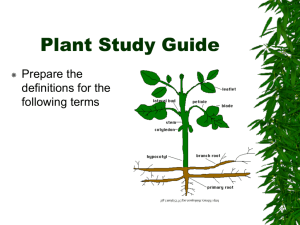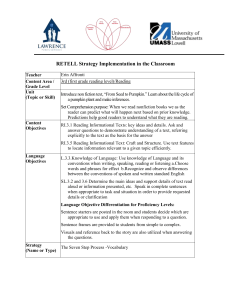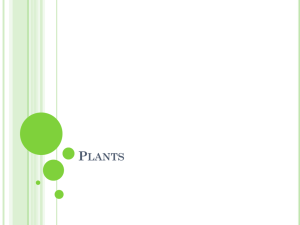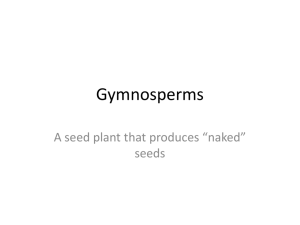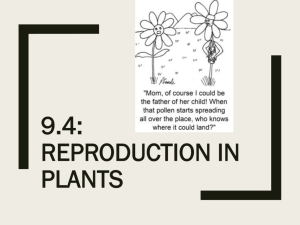Tomaskova dizertace - daglindgren.upsc.se
advertisement
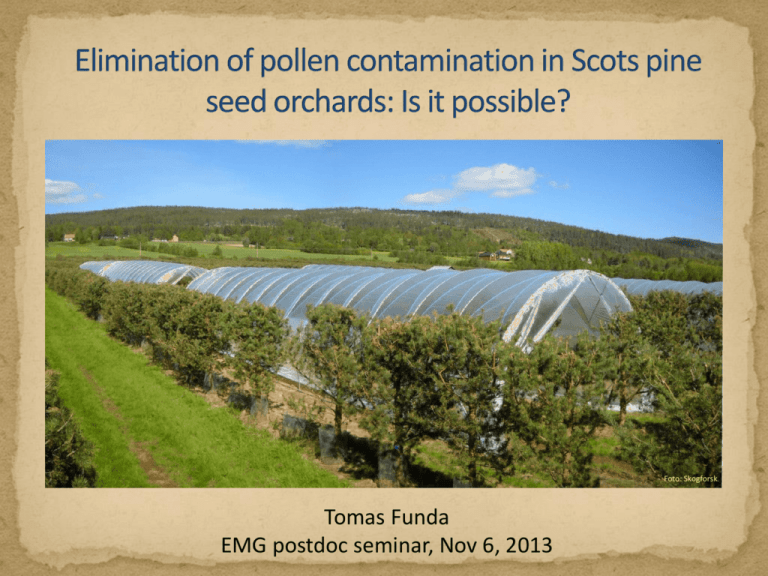
Foto: Skogforsk Tomas Funda EMG postdoc seminar, Nov 6, 2013 Tree Improvement scheme www.for.gov.bc.ca/hre/forgen Tree Improvement scheme Phenotypic selection www.for.gov.bc.ca/hre/forgen Tree Improvement scheme Evaluation of genetic quality www.for.gov.bc.ca/hre/forgen www.for.gov.bc.ca/hre/forgen Tree Improvement scheme Seed orchard establishment www.for.gov.bc.ca/hre/forgen Seed orchards Artificial populations of genetically superior trees Mass production of improved seed Assumptions • Random mating • No gene flow from outside Seed orchard crops’ quality Genetic gain Parental breeding values Reproductive success Pollen contamination Inbreeding depression <http://www.gowanuslounge.com> Genetic diversity Number of parents involved in mating (including contamination) Reproductive success Co-ancestry Inbreeding Foto: John Marshall Seed supply from seed orchards in Sweden Overall 71% Norway spruce 62% Scots pine 83% Newly established seed orchard Site after preparation for new seed orchard Mature seed orchard Pollen contamination Reduces genetic gain May cause maladaptation of progenies www.psmicrographs.co.uk Scots pine pollen grain More than 50% pollen contamination detected in Swedish seed orchards Foto: Kalamalka Forestry Centre, B.C. Reducing pollen contamination Several methods tested pollen dilution zones buffer stands larger orchards supplemental pollination phenological isolation Foto: Kalamalka Forestry Centre, B.C. • bloom delay (cooling by water mist) • different geographic region Generally low success! Foto: Western Forest Products Ltd. B.C. Isolation tents Scots pine seed orchard “Västerhus” ca 15 km east of Örnsköldsvik established 1991 13.7 ha 28 replicated parents Västerhus seed orchard‘s location Foto: Skogforsk Foto: Skogforsk Isolation tents Scots pine seed orchard “Västerhus” ca 15 km east of Örnsköldsvik established 1991 13.7 ha 28 replicated parents Target area for Västerhus seed © Google Isolation tents – design 10 experimental units 6 tents (3 treatments × 2 replicates) tent (no further treatment) tent + fan tent + supplemental pollination Foto: Skogforsk Tent + fan Foto: Skogforsk Tent + supplemental pollination 4 controls close to tents (centre) at the edges Provided by Skogforsk Isolation tents – design One ramet of 4 parents (AC3056, Y3012, Y3014 and Z2081) sampled in each experimental unit Extra pollen from 5 parents (AC1006, AC4221, Z3029, Z4003, Z4022) applied via SMP in two tents 1:1 C 1:3 T+F 1:4 T+P 1:2 T 2:3 T+F 2:2 T 2:1 C 2:4 T+P C_26 C C_103 C 1 AC3056 14 Y3014 27 AC3056 40 Y4103 52 Y3012 64 AC3015 77 Y3014 90 AC3056 103 AC3040 131 Z2081 2 Z2081 15 Y3012 28 Z2081 41 AC3065 53 AC3056 65 AC3056 78 91 Z2081 104 Z2081 132 Y3012 3 Y3014 16 AC3056 29 Y3012 42 Z2081 54 Y4103 66 Y3012 79 AC3056 92 Y3014 105 AC3056 133 Y3014 4 AC1075 17 30 AC3056 43 Y3014 55 Z4032 67 Z2081 80 93 106 Y3014 134 Z2081 5 AC3056 18 AC3065 31 Z4032 44 Y3012 56 AC3056 68 Y3014 81 Z2081 94 Y3012 107 Y3012 135 AC3056 6 Y3014 19 AC3040 32 Y3014 45 57 Y3012 69 Y3012 82 Y3014 95 AC3040 108 AC3056 136 Y3012 7 Z2081 20 AC1075 33 AC3056 46 Z2081 58 AC3040 70 AC3056 83 Y3012 96 AC3015 109 Z2081 137 AC3040 8 AC3056 21 AC3056 34 Y3012 47 Y3014 59 AC3015 71 AC3056 84 AC3056 97 AC3056 110 Y4103 138 AC3065 9 Y3012 22 Z2081 35 Z2081 48 Y3012 60 72 AC1075 85 AC3040 98 Y3012 111 AC3056 139 10 AC3040 23 AC3040 36 Y3014 49 AC3056 61 Z2081 73 Y3014 86 Y3012 99 Z2081 112 Y3014 140 Y4103 11 AC3015 24 Y3012 37 Y3012 50 Z4032 62 AC3056 74 Z2081 87 100 Y4103 113 Z2081 141 AC1075 12 Y3012 25 AC3056 38 51 AC3040 63 Y3014 75 Z2081 88 AC3015 101 AC1075 114 AC3056 142 Z2081 13 AC3056 26 Z4032 39 Z2081 144 AC3056 76 Y3014 89 Z2081 102 115 Y3012 143 Y3012 - Questions Do the plastic tents effectively isolate trees from background pollen sources? What is the effect of each treatment on genetic diversity of resulting seed crops? Does the limited number of fathers in tents result in higher rates of self-fertilization? selfing pollen contamination pollen leak Foto: Skogforsk Foto: Skogforsk Parentage determination Seed collection & extraction • 1408 seeds analyzed • 9 microsatellite markers • combined multilocus exclusion probability 0.9994 Germination DNA isolation Microsatellite genotyping Simple paternity exclusion Not complete match with any candidate father pollen contamination Complete match with a candidate father within-orchard mating Father the same as mother self-fertilization Father different from mother – outcrossing Pollen contamination in tents Experimental unit Contaminating / Treatment seeds count Number of analyzed seeds Pollen contamination [%] 1.2 T 0 140 0.0 2.2 T 0 124 0.0 1.3 T+F 0 143 0.0 2.3 T+F 0 150 0.0 1.4 T+P 0 146 0.0 2.4 T+P 0 160 0.0 Tents 0 863 0.0 1.1 C 6 142 4.2 2.1 C 6 146 4.1 C_26 C 8 129 6.2 C_103 C 8 128 6.3 Controls 28 545 5.1 × × pollen contamination Pollen leak into tents Experimental unit / Treatment Pollen leak count Total analyzed seeds Pollen leak [%] 1.2 T 0 140 0.0 2.2 T 0 124 0.0 1.3 T+F 1 143 0.7 2.3 T+F 0 150 0.0 1.4 T+P 2 146 1.4 2.4 T+P 1 160 0.6 Tents 4 863 0.5 pollen leak Pollen contamination Experimental Contamin. unit / seeds Treatment count Total analyzed seeds Pollen contam. [%] Pollen leak Experimental Total Pollen leak Pollen leak unit / analyzed count [%] Treatment seeds 1.2 T 0 140 0.0 1.2 T 0 140 0.0 2.2 T 0 124 0.0 2.2 T 0 124 0.0 1.3 T+F 0 143 0.0 1.3 T+F 1 143 0.7 2.3 T+F 0 150 0.0 2.3 T+F 0 150 0.0 1.4 T+P 0 146 0.0 1.4 T+P 2 146 1.4 2.4 T+P 0 160 0.0 2.4 T+P 1 160 0.6 Tents 0 863 0.0 Tents 4 863 0.5 1.1 C 6 142 4.2 2.1 C 6 146 4.1 C_26 C 8 129 6.2 C_103 C 8 128 6.3 28 545 5.1 Temperature sum above +5°C Controls Tents open 500 400 Control Control Tunnel Tent 300 Tents closed 200 100 0 1-May 11-May 21-May 31-May 10-Jun 20-Jun 30-Jun Heat sum accumulation tent vs. control Pollen contamination in controls Experimental unit Contaminating / Treatment seeds count Total analyzed seeds Pollen contamination [%] 1.2 T 0 140 0.0 2.2 T 0 124 0.0 1.3 T+F 0 143 0.0 2.3 T+F 0 150 0.0 1.4 T+P 0 146 0.0 2.4 T+P 0 160 0.0 Tents 0 863 0.0 1.1 C 6 142 4.2 2.1 C 6 146 4.1 C_26 C 8 129 6.2 C_103 C 8 128 6.3 Controls 28 545 5.1 Pollen contamination in controls Experimental unit Contaminating / Treatment seeds count Total analyzed seeds Pollen contamination [%] 1.2 T 0 140 0.0 2.2 T 0 124 0.0 1.3 T+F 0 143 0.0 2.3 T+F 0 150 0.0 1.4 T+P 0 146 0.0 2.4 T+P 0 160 0.0 Tents 0 863 0.0 1.1 C 6 142 4.2 2.1 C 6 146 4.1 C_26 C 8 129 6.2 C_103 C 8 128 6.3 Controls 28 545 5.1 Genetic diversity of seed crops 30 25 Colored: Effective number of fathers 20 White: Number of available fathers (census) 15 10 5 0 Genetic diversity of seed crops 30 25 Colored: Effective number of fathers 20 White: Number of available fathers (census) 15 10 5 0 Foto: Skogforsk Tent AC1006 AC4221 Z3029 Z4003 Z4022 Total SMP Total SMP success analyzed 146 56.2 1.4 T+P 9 14 15 23 21 82 2.4 T+P 23 20 12 17 29 101 160 63.1 Total 32 34 27 40 50 183 306 59.8 Selfing Fertilization of ovules by pollen from the same tree May lead to inbreeding depression reduction in economic value of forests (timber production, …) Selfing Factors affecting selfing Distance between replicates of the same parent Number of parents Fecundity Parental representation Reproductive phenology … Lstiburek and El-Kassaby (2010) Minimum inbreeding seed orchard design Selfing Treatment Count of selfed seeds Analyzed seeds Selfing [%] 1.2 T 15 140 10.7 2.2 T 43 124 34.7 1.3 T+F 31 143 21.7 Y3012 2:3 T+F parent composition 2.3 T+F 51 150 34.0 AC3056 Tents 140 557 25.1 Y4103 1.4 T+P 14 146 9.6 Z4032 2.4 T+P 12 160 7.5 Tents SMP 26 306 8.5 All tents 166 863 19.2 1.1 C 2 142 1.4 2.1 C 2 146 1.4 Z2081 C_26 C 12 129 9.3 AC3056 C_103 C 6 128 4.7 Y3014 545 4.0 AC3056 Controls 22 AC3056 Y3012 AC3040 AC3015 × Foto: Skogforsk Summary / Conclusion Too early to make a conclusion … The isolation tents fully eliminated pollen contamination from the studied Scots pine seed orchard The effective number of father (Ne) was very low in the tents Selfing was too high in the tents Supplemental mass pollination (SMP) substantially improved seed crops in terms of both Ne and selfing © Google Foto: Skogforsk Next steps Seed crop from 2012 and possibly 2013 Fine scale assessment of mating dynamics in the tents Cost-benefit evaluation of the tent isolation method Foto: Anders Fries Xiao-Ru Wang Curt Almqvist Ulfstand Wennström Bengt Andersson Jin Pan Baosheng Wang Takeshi Torimaru Financial support Föreningen Skogsträdsförädling Summary / Conclusion Too early to make a conclusion … The isolation tents fully eliminated pollen contamination from the studied Scots pine seed orchard The effective number of father (Ne) was very low in the tents Selfing was too high in the tents Supplemental mass pollination (SMP) substantially improved tent seed crops in terms of both Ne and selfing © Google Foto: Skogforsk


